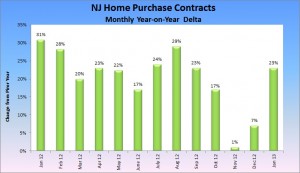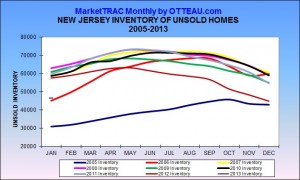While buyers have been fighting over expensive Manhattan apartments and prices rose across the rest of the country, single-family home prices were drifting lower across the New York metropolitan area, according to new data reported by Standard & Poor’s Case-Shiller index.
The index differed significantly from more-upbeat local reports in both New York and New Jersey toward the end of last year. The other reports showed considerable signs of strength and an improvement in median sale prices, amid declining inventory in both states.
Analysts attributed the contrasting results to differences in methodology and timing, as well as a faster pace of foreclosures in New York and New Jersey, at a time when they are slowing elsewhere in the country. Sales delayed by superstorm Sandy may have also had an impact.
The Case-Shiller index found that home prices across the region fell by just over 0.5% in the 12 months through December compared with a year earlier. Prices rose in all of the other 19 metropolitan areas tracked by the index during the same period, signaling a stronger national housing market.
…
Sales in the New York region fared better than much of the country during the downturn, but the area has performed worse in recent months, according to the Case-Shiller report. It showed local prices sliding each month since August, for a total decline of 2.7%.
Yet despite the ups and downs of the last decade, prices were up 43% in the New York metropolitan area since 2001, compared with 30% for the 20-city index as a whole during that period.
A few weeks ago, Jeffrey G. Otteau, an appraiser and founder of Otteau Valuation Group, reported that strong job growth had led to a “steady improvement in the home purchase market” in New Jersey over the last 18 months. He said median prices were up 2.9% in the fourth quarter, compared with the same quarter in 2011.
In an interview, Mr. Otteau said that monthly measurements of home prices “are unstable to begin with.” He said that Sandy had triggered a decline in sales both along the damaged shorelines and in many nearby communities as well.
Now, he said, the foreclosure process is accelerating as well, and distress sales often depress housing prices. New Jersey ranks second after Florida for largest percentage of mortgaged homes in the foreclosure process. It had 7% in foreclosure in December. New York ranked third with 5.8%, according to CoreLogic.
Last month, Douglas Elliman reported median sale prices were up 3.2% on Long Island, excluding the Hamptons, in the fourth quarter compared with the same quarter a year earlier, but prices were down from the third quarter.
Jonathan Miller, an appraiser and president of Miller Samuel Inc., who prepared the Elliman report, said that the Case-Shiller data tended to lag behind data available within a local market.
The Case-Shiller index is calculated from changes in prices on individual homes as they are resold during a moving three-month period. Craig Lazzara, a senior director at S&P Dow Jones Indices, said the index includes foreclosure sales conducted on the open market.
He attributed the weak local housing market to New York’s dependence on the financial sector, where the recovery in “its hometown” industry has been slow.




